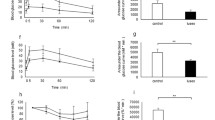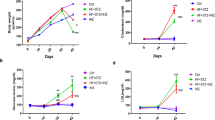Abstract
This study was designed to investigate effect of metformin or pioglitazone on β-catenin and biochemical indicators in sitagliptin-induced pancreatitis. Type 2 diabetes mellitus was induced by high-fat diet/low-dose streptozotocin. Six groups (n = 8) were used: diabetic control group and five treated groups given, for 6 weeks by oral gavage, metformin (100 mg/kg/day), pioglitazone (20 mg/kg/day), sitagliptin (30 mg/kg/day), metformin + sitagliptin (MS), and pioglitazone + sitagliptin (PS). Body weight (BW) and biochemical parameters (fasting blood sugar (FBS), glycated hemoglobin (HbA1c), insulin, total cholesterol (TC), triglycerides (TG), malondialdehyde (MDA), and amylase) were measured. Pancreatic sections were examined using hematoxylin and eosin staining and immunohistochemical staining for β-catenin protein. Only pioglitazone significantly increased BW. All treatments significantly decreased FBS, HbA1c, TC, TG, MDA, and amylase minimally with sitagliptin and maximally with combination therapies. Moreover, all treatments significantly increased insulin except pioglitazone which showed a nonsignificant decrease. Both metformin and pioglitazone ameliorated the diabetic-induced changes while sitagliptin-treated rats showed signs suggestive of pancreatitis. Sitagliptin failed to inhibit the inappropriately increased β-catenin expression predisposing for pancreatitis but helping regenerate streptozotocin-damaged islets. Metformin and pioglitazone alone or combined with sitagliptin decreased the inappropriate β-catenin expression. In conclusion, the decrease in β-catenin seems to be involved in reversal of sitagliptin-associated pancreatitis by metformin or pioglitazone. The better regeneration of islets with metformin and pioglitazone, than sitagliptin, may be due to better effectiveness in controlling diabetes. Sitagliptin should be used in combination with metformin or pioglitazone. Further studies are needed to determine mechanisms underlying role of Wnt/β-catenin in regeneration of islets and exocrine pancreas.



Similar content being viewed by others
References
Abe M, Okada K, Soma M. Antidiabetic agents in patients with chronic kidney disease and end-stage renal disease on dialysis: metabolism and clinical practice. Curr Drug Metab. 2011;12:57–69.
Pala L, Pezzatini A, Dicembrini I, Ciani S, Gelmini S, Vannelli BG, et al. Different modulation of dipeptidyl peptidase-4 activity between microvascular and macrovascular human endothelial cells. Acta Diabetol. 2010;49 Suppl 1:59–63.
Viollet B, Guigas B, Sanz Garcia N, Leclerc J, Foretz M, Andreelli F. Cellular and molecular mechanisms of metformin: an overview. Clin Sci. 2012;122:253–70.
Larsen PJ, Wulff EM, Gotfredsen CF, Brand CL, Sturis J, Vrang N, et al. Combination of the insulin sensitizer, pioglitazone, and the long-acting GLP-1 human analog, liraglutide, exerts potent synergistic glucose-lowering efficacy in severely diabetic ZDF rats. Diabetes Obes Metab. 2008;10:301–11.
Olansky L. Q: Do incretin drugs for type 2 diabetes increase the risk of acute pancreatitis? Cleve Clin J Med. 2010;77:503–5.
Matveyenko AV, Dry S, Cox HI, Moshtaghian A, Gurlo T, Galasso R, et al. Beneficial endocrine but adverse exocrine effects of sitagliptin in the human islet amyloid polypeptide transgenic rat model of type 2 diabetes: interactions with metformin. Diabetes. 2009;58:1604–15.
Reddy RC, Hao Y, Lee SH, Gangireddy SR, Owyang C, DiMagno MJ. Pioglitazone reverses insulin resistance and impaired CCK-stimulated pancreatic secretion in eNOS(-/-) mice: therapy for exocrine pancreatic disorders? Am J Physiol Gastrointest Liver Physiol. 2007;293:G112–20.
Elghazi L, Gould AP, Weiss AJ, Barker DJ, Callaghan J, Opland D, et al. Importance of β-catenin in glucose and energy homeostasis. Sci Rep. 2012;2:693.
Welters HJ, Kulkarni RN. Wnt signaling: relevance to beta-cell biology and diabetes. Trends Endocrinol Metab. 2008;19:349–55.
Keefe MD, Wang H, De La OJP, Khan A, Firpo MA. Murtaugh LC β-catenin is selectively required for the expansion and regeneration of mature pancreatic acinar cells in mice. Dis Model Mech. 2012;5:503–14.
Srinivasan K, Viswanad B, Asrat L, Kaul CL, Ramarao P. Combination of high-fat diet-fed and low-dose streptozotocin-treated rat: a model for type 2 diabetes and pharmacological screening. Pharmacol Res. 2005;52:313–20.
Tatarkiewicz K, Smith PA, Sablan EJ, Polizzi CJ, Aumann DE, Villescaz C, et al. Exenatide does not evoke pancreatitis and attenuates chemically induced pancreatitis in normal and diabetic rodents. Am J Physiol Endocrinol Metab. 2010;299:E1076–86.
Sun X, Han F, Yi J, Han L, Wang B. Effect of aspirin on the expression of hepatocyte NF-κB and serum TNF-α in streptozotocin-induced type 2 diabetic rats. J Korean Med Sci. 2011;26:765–70.
Ding SY, Shen ZF, Chen YT, Sun SJ, Liu Q, Xie MZ. Pioglitazone can ameliorate insulin resistance in low-dose streptozotocin and high sucrose-fat diet induced obese rats. Acta Pharmacol Sin. 2005;26:575–80.
Chen B, Moore A, Escobedo LV, Koletsky MS, Hou D, Koletsky RJ, et al. Sitagliptin lowers glucagon and improves glucose tolerance in prediabetic obese SHROB rats. Exp Biol Med. 2011;236:309–14.
Ferreira L, Teixeira-de-Lemos E, Pinto F, Parada B, Mega C, Vala H, et al. Effects of sitagliptin treatment on dysmetabolism, inflammation, and oxidative stress in an animal model of type 2 diabetes (ZDF Rat). Med Inflam. 2010; Article ID 592760, 11 pages
Wang Q-M, Zhang Y, Yang K-M, Zhou H-Y, Yang H-J. Wnt/β-catenin signaling pathway is active in pancreatic development of rat embryo. World J Gastroenterol. 2006;12:2615–19.
Mu J, Petrov A, Eiermann GJ, Woods J, Zhou YP, Li Z, et al. Inhibition of DPP-4 with sitagliptin improves glycemic control and restores islet cell mass and function in a rodent model of type 2 diabetes. Eur J Pharmacol. 2009;623:148–54.
Mega C, de Lemos ET, Vala H, Fernandes R, Oliveira J, Mascarenhas-Melo F, et al. Diabetic nephropathy amelioration by a low-dose sitagliptin in an animal model of type 2 diabetes (Zucker diabetic fatty rat). Exp Diab Res. 2011; Article ID 162092, 12 pages
Reimer RA, Grover GJ, Koetzner L, Gahler RJ, Juneja P, Lyon MR, et al. Sitagliptin reduces hyperglycemia and increases satiety hormone secretion more effectively when used with a novel polysaccharide in obese Zucker rats. J Nutr. 2012;142:1812–20.
Yeom JA, Kim ES, Park HS, Ham DS, Sun C, Kim JW, et al. Both sitagliptin analogue & pioglitazone preserve the beta-cell proportion in the islets with different mechanism in non-obese and obese diabetic mice. BMB Rep. 2011;44:713–8.
Sartori DRS, Kawakami CL, Orsatti CL, Sforcin JM. Propolis effect on streptozotocin-induced diabetic rats. J Venom Anim Toxins incl Trop Dis. 2009;15:93–102.
Mayer J, Rau B, Gansauge F, Beger HG. Inflammatory mediators in human acute pancreatitis: clinical and pathophysiological implications. Gut. 2000;47:546–52.
Di Sebastiano P, di Mola FF, Di Febbo C, Baccante G, Porreca E, Innocenti P, et al. Expression of interleukin 8 (IL-8) and substance P in human chronic pancreatitis. Gut. 2000;47:423–8.
Butler PC, Matveyenko AV, Dry S, Bhushan A, Elashoff R. Glucagon-like peptide-1 therapy and the exocrine pancreas: innocent bystander or friendly fire? Diabetologia. 2010;53:1–6.
Reichert M. Rustgi AK pancreatic ductal cells in development, regeneration, and neoplasia. J Clin Invest. 2011;121:4572–8.
Scotti ML, Smith KE, Butler AM, Calcagno SR, Crawford HC, Leitges M, et al. Protein kinase C iota regulates pancreatic acinar-to-ductal metaplasia. PLoS ONE. 2012;7:e30509.
Konturek PC, Dembinski A, Warzecha Z, Burnat G, Ceranowicz P, Hahn EG, et al. Pioglitazone, a specific ligand of peroxisome proliferator-activated receptor-gamma, protects pancreas against acute cerulein-induced pancreatitis. World J Gastroenterol. 2005;28(11):6322–9.
Xu G, Kaneto H, Lopez-Avalos MD, Weir GC, Bonner-Weir S. GLP-1/exendin-4 facilitates beta-cell neogenesis in rat and human pancreatic ducts. Diabetes Res Clin Pract. 2006;73:107–10.
Kanda Y, Shimoda M, Hamamoto S, Tawaramoto K, Kawasaki F, Hashiramoto M, et al. Molecular mechanism by which pioglitazone preserves pancreatic beta-cells in obese diabetic mice: evidence for acute and chronic actions as a PPARgamma agonist. Am J Physiol Endocrinol Metab. 2010;298:E278–86.
Chiang YT, Ip W, Jin T. The role of the Wnt signaling pathway in incretin hormone production and function. Front Physiol. 2012;3:273.
Portha B, Tourrel-Cuzin C, Movassat J. Activation of the GLP-1 receptor signalling pathway: a relevant strategy to repair a deficient beta-cell mass. Exp Diabetes Res. 2011:376509
Liu Z, Habener JF. Glucagon-like peptide-1 activation of TCF7L2-dependent Wnt signaling enhances pancreatic beta cell proliferation. J Biol Chem. 2008;283:8723–35.
Lenhard JM, Croom DK, Minnick DT. Reduced serum dipeptidyl peptidase-IV after metformin and pioglitazone treatments. Biochem Biophys Res Commun. 2004;5(324):92–7.
Kim M-H, Lee M-S, Kim K-W, Hur KY, Kim JH, Lee MK. Metfomin stimulates glucagon-like peptide (GLP-1) synthesis and secretion via Wnt signaling. 2010; 278.
Heller C, Kühn MC, Mülders-Opgenoorth B, Schott M, Willenberg HS, Scherbaum WA, et al. Exendin-4 upregulates the expression of Wnt-4, a novel regulator of pancreatic β-cell proliferation. Am J Physiol Endocrinol Metab. 2011;301:E864–72.
Hammarstedt A, Isakson P, Gustafson B, Smith U. Wnt-signaling is maintained and adipogenesis inhibited by TNFalpha but not MCP-1 and resistin. Biochem Biophys Res Commun. 2007;357:700–6.
Takatani T, Minagawa M, Takatani R, Kinoshita K, Kohno Y. AMP-activated protein kinase attenuates Wnt/β-catenin signaling in human osteoblastic Saos-2 cells. Mol Cell Endocrinol. 2011;339:114–9.
Siveke JT, Lubeseder-Martellato C, Lee M, Mazur PK, Nakhai H, Radtke F, et al. Notch signaling is required for exocrine regeneration after acute pancreatitis. Gastroenterology. 2008;134:544–55.
Figeac F, Uzan B, Faro M, Chelali N, Portha B, Movassat J. Neonatal growth and regeneration of beta-cells are regulated by the Wnt/beta-catenin signaling in normal and diabetic rats. Am J Physiol Endocrinol Metab. 2010;298:E245–56.
Dessimoz J, Bonnard C, Huelsken J, Grapin-Botton A. Pancreas-specific deletion of beta-catenin reveals Wnt-dependent and Wnt-independent functions during development. Curr Biol. 2005;15:1677–83.
Chocarro-Calvo A, García-Martínez JM, Ardila-González S, De la Vieja A, García-Jiménez C. Glucose-induced β-catenin acetylation enhances Wnt signaling in cancer. Mol Cell. 2012;49:474–86.
Shimasaki T, Kitano A, Motoo Y, Minamoto T. Aberrant glycogen synthase kinase 3β in the development of pancreatic cancer. J Carcinog. 2012;11:15.
Abiola M, Favier M, Christodoulou-Vafeiadou E, Pichard AL, Martelly I, Guillet-Deniau I. Activation of Wnt/beta-catenin signaling increases insulin sensitivity through a reciprocal regulation of Wnt10b and SREBP-1c in skeletal muscle cells. PLoS One. 2009;4(12):e8509.
Acknowledgments
This project was funded by the Deanship of Scientific Research (DSR), King Abdulaziz University (KAU), Jeddah, under grant number 195/828/1432. The authors, therefore, acknowledge with thanks DSR technical and financial support.
Conflict of interest
None
Author information
Authors and Affiliations
Corresponding author
Rights and permissions
About this article
Cite this article
Murad, H.A.S., Saleh, H.A., Abdulaziz, G.S. et al. Effect of metformin and pioglitazone on β-catenin and biochemical markers in sitagliptin-induced pancreatitis in diabetic rats. Int J Diabetes Dev Ctries 35, 332–339 (2015). https://doi.org/10.1007/s13410-014-0278-8
Received:
Accepted:
Published:
Issue Date:
DOI: https://doi.org/10.1007/s13410-014-0278-8




